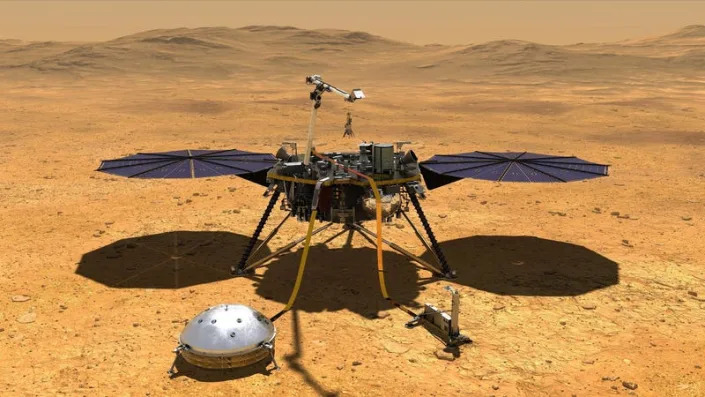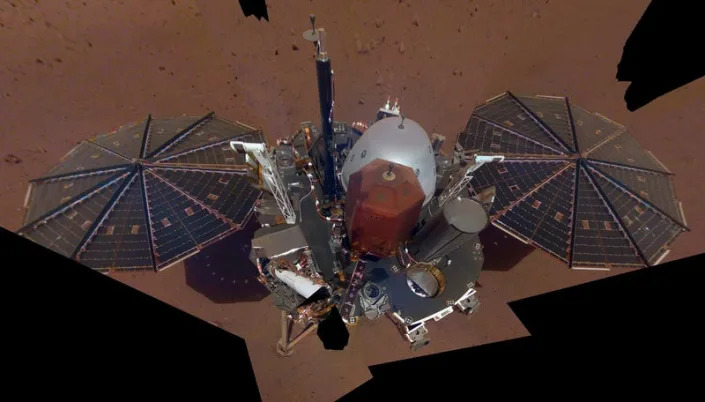Luke Plunkett
Mon, December 19, 2022

Image: NASA
InSight—or, less elegantly, the Interior Exploration using Seismic Investigations, Geodesy and Heat Transport mission—is a robot that NASA’s JPL (with help from the European Space Agency) sent to Mars back in 2018.
It’s job was fairly simple. Or as simple as “a highly complex robot built on Earth then fired from a rocket into deep space then landed on another planet” can be, anyway. InSight put a seismometer on Mars and has sat around for the last four years reading and interpreting the data received from it, killing its time providing “accurate 3D models of the planet’s interior” and measuring “internal heat transfer using a heat probe called HP3 to study Mars’ early geological evolution”.

A selfie taken by InSight back in 2018
Aside from its main role, InSight has also been useful because it has a camera attached, allowing it to take some very nice photos of the surface of Mars. Its coolest achievement, however, at least for anyone not in the field of hardcore space science, is the fact that the robot was able—via vibrations detected on its solar panels—to record the sound of wind on Mars, which is the first time anyone had ever heard wind from another planet.
Sounds of Mars: NASA’s InSight Senses Martian Wind
So yeah, nice robot! But like any robot sent into space, InSight is running on a battery, and while solar panels and judicious use of its systems have helped prologue its life, the time is fast approaching where it runs out of juice for good and is forced to power down.
This should be a routine matter. This is a machine, it’s going to stop working, we will all get on with our lives. But somebody at NASA had the bright/terrible idea to anthropomorphize InSight’s final days, and so instead of a press report saying “machine stopped working, it did neat stuff”, we have to read this:
Excuse me. I just have some...Martian dust in my eye.
I hope, one day soon, we ourselves are able to travel to Mars. And when we get there, I hope one of the first things we do is find InSight, and give it a hug.
NASA's Mars lander InSight transmits potential final image of the Red Planet as its power dwindles

NASA's Mars lander InSight transmits potential final image of the Red Planet as its power dwindles
Paul Best
Mon, December 19, 2022
NASA’s InSight Mars lander, which touched down on the Red Planet over four years ago, transmitted what may be its final image on Monday.
"My power’s really low, so this may be the last image I can send. Don’t worry about me though: my time here has been both productive and serene. If I can keep talking to my mission team, I will – but I’ll be signing off here soon," Insight's 25-30 person team posted to the lander's Twitter on Monday afternoon. "Thanks for staying with me."

The potential final image NASA’s InSight Mars lander, which is expected to run out of power later this month.
NASA will officially end the mission when the lander misses two communication attempts in a row with a spacecraft orbiting the planet.
InSight's operations team started preparing for the lander's end earlier this year, shutting down devices that require the most power and ensuring that data it has collected over the past four years is preserved.

Selfie taken by the Insight lander's Instrument Deployment Camera

Thick layer of dust on one of the lander's solar panels.
The lander's core mission was accomplished in its first two years. A pair of 7-foot wide solar panels initially produced about 5,000 watt-hours each sol, or Martian day, but were only producing about 500 watt-hours per sol last month as dust has accumulated.

NASA's Mars lander InSight transmits potential final image of the Red Planet as its power dwindles
Paul Best
Mon, December 19, 2022
NASA’s InSight Mars lander, which touched down on the Red Planet over four years ago, transmitted what may be its final image on Monday.
"My power’s really low, so this may be the last image I can send. Don’t worry about me though: my time here has been both productive and serene. If I can keep talking to my mission team, I will – but I’ll be signing off here soon," Insight's 25-30 person team posted to the lander's Twitter on Monday afternoon. "Thanks for staying with me."

The potential final image NASA’s InSight Mars lander, which is expected to run out of power later this month.
NASA will officially end the mission when the lander misses two communication attempts in a row with a spacecraft orbiting the planet.
InSight's operations team started preparing for the lander's end earlier this year, shutting down devices that require the most power and ensuring that data it has collected over the past four years is preserved.

Selfie taken by the Insight lander's Instrument Deployment Camera
on the lander’s robotic arm on April 11, 2019.
Since it landed in November 2018, the lander has provided insight on Mars' liquid core and the composition of its other interior layers. It has detected more than 1,300 quakes on the planet, including a magnitude 5 in May.
"Finally, we can see Mars as a planet with layers, with different thicknesses, compositions," Bruce Banerdt of NASA’s Jet Propulsion Laboratory in Southern California said in a statement last month. "We’re starting to really tease out the details. Now it’s not just this enigma; it’s actually a living, breathing planet."
Since it landed in November 2018, the lander has provided insight on Mars' liquid core and the composition of its other interior layers. It has detected more than 1,300 quakes on the planet, including a magnitude 5 in May.
"Finally, we can see Mars as a planet with layers, with different thicknesses, compositions," Bruce Banerdt of NASA’s Jet Propulsion Laboratory in Southern California said in a statement last month. "We’re starting to really tease out the details. Now it’s not just this enigma; it’s actually a living, breathing planet."

Thick layer of dust on one of the lander's solar panels.
The lander's core mission was accomplished in its first two years. A pair of 7-foot wide solar panels initially produced about 5,000 watt-hours each sol, or Martian day, but were only producing about 500 watt-hours per sol last month as dust has accumulated.
No comments:
Post a Comment